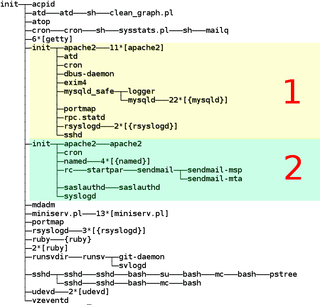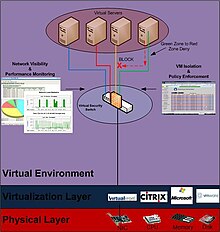A virtual storage area network is a logical representation of a physical storage area network (SAN). A VSAN abstracts the storage-related operations from the physical storage layer, and provides shared storage access to the applications and virtual machines by combining the servers' local storage over a network into a single or multiple storage pools.
OS-level virtualization is an operating system (OS) virtualization paradigm in which the kernel allows the existence of multiple isolated user space instances, called containers, zones, virtual private servers (OpenVZ), partitions, virtual environments (VEs), virtual kernels, or jails. Such instances may look like real computers from the point of view of programs running in them. A computer program running on an ordinary operating system can see all resources of that computer. However, programs running inside of a container can only see the container's contents and devices assigned to the container.

OpenVZ is an operating-system-level virtualization technology for Linux. It allows a physical server to run multiple isolated operating system instances, called containers, virtual private servers (VPSs), or virtual environments (VEs). OpenVZ is similar to Solaris Containers and LXC.
The following is a timeline of virtualization development. In computing, virtualization is the use of a computer to simulate another computer. Through virtualization, a host simulates a guest by exposing virtual hardware devices, which may be done through software or by allowing access to a physical device connected to the machine.
Desktop virtualization is a software technology that separates the desktop environment and associated application software from the physical client device that is used to access it.

VMware ESXi is an enterprise-class, type-1 hypervisor developed by VMware, a subsidiary of Broadcom, for deploying and serving virtual computers. As a type-1 hypervisor, ESXi is not a software application that is installed on an operating system (OS); instead, it includes and integrates vital OS components, such as a kernel.
Hardware virtualization is the virtualization of computers as complete hardware platforms, certain logical abstractions of their componentry, or only the functionality required to run various operating systems. Virtualization hides the physical characteristics of a computing platform from the users, presenting instead an abstract computing platform. At its origins, the software that controlled virtualization was called a "control program", but the terms "hypervisor" or "virtual machine monitor" became preferred over time.

Microsoft Hyper-V, codenamed Viridian, and briefly known before its release as Windows Server Virtualization, is a native hypervisor; it can create virtual machines on x86-64 systems running Windows. Starting with Windows 8, Hyper-V superseded Windows Virtual PC as the hardware virtualization component of the client editions of Windows NT. A server computer running Hyper-V can be configured to expose individual virtual machines to one or more networks. Hyper-V was first released with Windows Server 2008, and has been available without additional charge since Windows Server 2012 and Windows 8. A standalone Windows Hyper-V Server is free, but has a command-line interface only. The last version of free Hyper-V Server is Hyper-V Server 2019, which is based on Windows Server 2019.
Infrastructure as a service (IaaS) is a cloud computing service model by means of which computing resources are supplied by a cloud services provider. The IaaS vendor provides the storage, network, servers, and virtualization. This service enables users to free themselves from maintaining an on-premises data center. The IaaS provider is hosting these resources in either the public cloud, the private cloud, or the hybrid cloud.
In computing, network virtualization is the process of combining hardware and software network resources and network functionality into a single, software-based administrative entity, a virtual network. Network virtualization involves platform virtualization, often combined with resource virtualization.
A virtual security appliance is a computer appliance that runs inside virtual environments. It is called an appliance because it is pre-packaged with a hardened operating system and a security application and runs on a virtualized hardware. The hardware is virtualized using hypervisor technology delivered by companies such as VMware, Citrix and Microsoft. The security application may vary depending on the particular network security vendor. Some vendors such as Reflex Systems have chosen to deliver Intrusion Prevention technology as a Virtualized Appliance, or as a multifunctional server vulnerability shield delivered by Blue Lane. The type of security technology is irrelevant when it comes to the definition of a Virtual Security Appliance and is more relevant when it comes to the performance levels achieved when deploying various types of security as a virtual security appliance. Other issues include visibility into the hypervisor and the virtual network that runs inside.
In computing, virtualization or virtualisation in British English is the act of creating a virtual version of something at the same abstraction level, including virtual computer hardware platforms, storage devices, and computer network resources.
Eucalyptus is a paid and open-source computer software for building Amazon Web Services (AWS)-compatible private and hybrid cloud computing environments, originally developed by the company Eucalyptus Systems. Eucalyptus is an acronym for Elastic Utility Computing Architecture for Linking Your Programs To Useful Systems. Eucalyptus enables pooling compute, storage, and network resources that can be dynamically scaled up or down as application workloads change. Mårten Mickos was the CEO of Eucalyptus. In September 2014, Eucalyptus was acquired by Hewlett-Packard and then maintained by DXC Technology. After DXC stopped developing the product in late 2017, AppScale Systems forked the code and started supporting Eucalyptus customers.
A virtual firewall (VF) is a network firewall service or appliance running entirely within a virtualized environment and which provides the usual packet filtering and monitoring provided via a physical network firewall. The VF can be realized as a traditional software firewall on a guest virtual machine already running, a purpose-built virtual security appliance designed with virtual network security in mind, a virtual switch with additional security capabilities, or a managed kernel process running within the host hypervisor.
Temporal isolation or performance isolation among virtual machine (VMs) refers to the capability of isolating the temporal behavior of multiple VMs among each other, despite them running on the same physical host and sharing a set of physical resources such as processors, memory, and disks.

OpenNebula is an open source cloud computing platform for managing heterogeneous data center, public cloud and edge computing infrastructure resources. OpenNebula manages on-premises and remote virtual infrastructure to build private, public, or hybrid implementations of Infrastructure as a Service and multi-tenant Kubernetes deployments. The two primary uses of the OpenNebula platform are data center virtualization and cloud deployments based on the KVM hypervisor, LXD/LXC system containers, and AWS Firecracker microVMs. The platform is also capable of offering the cloud infrastructure necessary to operate a cloud on top of existing VMware infrastructure. In early June 2020, OpenNebula announced the release of a new Enterprise Edition for corporate users, along with a Community Edition. OpenNebula CE is free and open-source software, released under the Apache License version 2. OpenNebula CE comes with free access to patch releases containing critical bug fixes but with no access to the regular EE maintenance releases. Upgrades to the latest minor/major version is only available for CE users with non-commercial deployments or with significant open source contributions to the OpenNebula Community. OpenNebula EE is distributed under a closed-source license and requires a commercial Subscription.
Google Compute Engine (GCE) is the Infrastructure as a Service (IaaS) component of Google Cloud Platform which is built on the global infrastructure that runs Google's search engine, Gmail, YouTube and other services. Google Compute Engine enables users to launch virtual machines (VMs) on demand. VMs can be launched from the standard images or custom images created by users. GCE users must authenticate based on OAuth 2.0 before launching the VMs. Google Compute Engine can be accessed via the Developer Console, RESTful API or command-line interface (CLI).
Software-defined storage (SDS) is a marketing term for computer data storage software for policy-based provisioning and management of data storage independent of the underlying hardware. Software-defined storage typically includes a form of storage virtualization to separate the storage hardware from the software that manages it. The software enabling a software-defined storage environment may also provide policy management for features such as data deduplication, replication, thin provisioning, snapshots and backup.
Network functions virtualization (NFV) is a network architecture concept that leverages IT virtualization technologies to virtualize entire classes of network node functions into building blocks that may connect, or chain together, to create and deliver communication services.
A network virtualization platform decouples the hardware plane from the software plane such that the host hardware plane can be administratively programmed to assign its resources to the software plane. This allows for the virtualization of CPU, memory, disk and most importantly network IO. Upon such virtualization of hardware resources, the platform can accommodate multiple virtual network applications such as firewalls, routers, Web filters, and intrusion prevention systems, all functioning much like standalone hardware appliances, but contained within a single hardware appliance. The key benefit to such technology is doing all of this while maintaining the network performance typically seen with that of standalone network appliances as well as enabling the ability to administratively or dynamically program resources at will.




